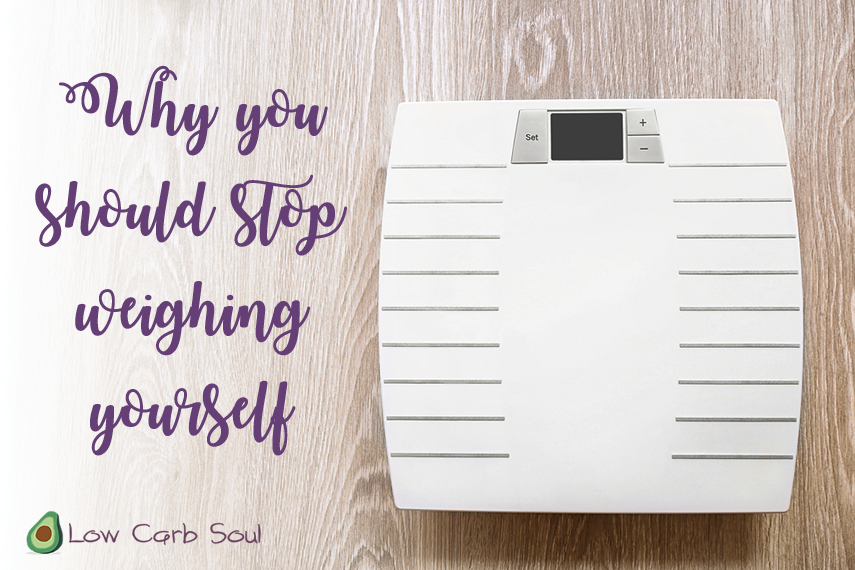Why you should stop weighing yourself
Keto is commonly used for weight loss, and for good reason. Done correctly, it can be a very successful weight-loss approach. It’s definitely what I recommend if you’re struggling with your weight and have had difficulty losing weight or keeping it off in the past. (My goals with keto were not weight-related, but I lost 20 pounds effortlessly and am now comfortably fitting into clothes that I had come close to getting rid of because they were too tight.)
Weight loss on keto
That said, like any other diet, keto is not a magic pill. Losing weight takes time — you didn’t gain all the weight overnight, and even with keto, you can’t expect it to disappear overnight. I often see people lamenting the fact that they aren’t losing weight faster, or that their weight starts creeping back up. It’s important to go into any new WOE (way of eating) with realistic expectations. Healthy weight loss occurs at the rate of about 1-2 pounds per week. With keto, you will likely experience rapid weight loss in the beginning (due to your body using glycogen stores), and then slow down.
Most people assume weight loss is a steady decline, but that’s not how it works. This is a great graphic I often see floating around online to demonstrate the process (sorry I don’t know who originally created this but if you know, I will gladly give that person credit):
Your weight will constantly fluctuate. In fact, it could change as much as 5 pounds in a single day, depending on when you weigh yourself, how much you’ve had to eat or drink, or other factors, such as hormone fluctuations. (Ladies, your weight will likely tick back up during menstruation.)
If you are constantly weighing yourself and stressing out over why the number isn’t changing fast enough, I want you to do something:
Throw away your scale. Or at least, put it somewhere you won’t see it every day, and pledge to weigh yourself no more than once a week.
Here’s the thing: weight is only one marker of your health. It doesn’t tell you how much body fat you actually have, or how healthy you actually are. If we fixate too much on the number on the scale, we’re missing a lot of other important markers. It’s entirely possible that as you adjust to keto, your body composition may change, but your actual rate of weight loss may be slower. Also if you’re doing strength training, you could be replacing fat with muscle, which is denser than fat and therefore, yes, weighs more by volume. (This process also takes a while, so don’t expect to see a huge difference after lifting weights once or twice.)
Tracking your progress on keto
There are 2 methods of tracking your progress on keto (or any weight-loss plan) that are much better than weighing yourself: take pictures and measurements. Both of these will give you a more accurate picture of how your body is changing.
When taking pictures, wear clothes that reveal your body (bra and underwear are best — don’t worry, you don’t have to share these pictures with anyone if you don’t want to). Try to take your photos in the same clothes and the same location to make it easier to compare them. Take photos in front of a blank wall to eliminate distracting elements in the background, and use good lighting. Take closeups of your face as well. This will make it easier to detect changes that you won’t notice by looking at yourself in the mirror every day.
When taking measurements, measure your waist, hips, chest, thighs, arms, and anything else you want to track. Take your measurements and photos once a week and keep track of them in a designated notebook / folder on your phone or computer — wherever you can easily group them together and find them later.
Write down your non-scale victories
Another good way to keep track of your progress is to write down your NSVs (non-scale victories). These are any goals not related to the number on the scale. NSVs are different for everyone, but the following are some common examples:
- Being able to fit into a favorite pair of jeans again
- Feeling comfortable in your own skin
- Feeling comfortable having your photo taken
- Feeling comfortable looking at yourself in the mirror naked
- Feeling comfortable enough to get a tattoo (or doing anything else you have been putting off due to your weight)
- Feeling comfortable wearing a swimsuit at the beach / pool
- Having more confidence sexually
- Getting pregnant
- Being able to shop at regular clothing stores
- Walking into any clothing store and knowing you will find something that fits
- Being able to stop taking certain medications
- Getting rid of heartburn
- Having more energy
- Thinking more clearly
Take a few minutes and write down all the non-scale victories you can think of, so that you will be more likely to recognize them when they occur. Whenever you think of new ones, add them to your list. Whenever a NSV occurs, write it down on your calendar or wherever you keep track of your progress. When you feel discouraged about your weight loss or feel that you aren’t making enough progress, review your photos, measurements, and list of successful NSVs to remind yourself of how far you have come. There will be times when it feels like you’re stuck — this is normal. Trust the process and don’t get discouraged. It is very likely that changes are happening inside your body that you just can’t see.
Tags In
Karen
Leave a Reply Cancel reply
Categories
- Holistic Health (3)
- Ketogenic diet (4)
- Meal Planning (3)
- Nutrition (1)
- Recipes (2)
- Weight Loss (2)




